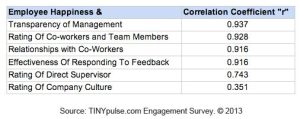When it comes to transparency, many organizations struggle with determining how much information (financials, operational activity, organizational changes, etc.) is appropriate to disclose. Fearing backlash from employees and the public alike, many companies choose to disclose as little as possible.
But here’s the thing about communications today, it’s hard to operate an organization without some form of transparency — voluntary or otherwise. Employees are savvy, and our communications channels are more porous than ever thanks to smartphones, and social media documenting everything we do. Sensitive information has a way of getting in front of sensitive audiences because it’s never been easier to share.
What we tend to overlook about transparency is that often it’s not the content of the information that matters, it’s more so the context and how it’s delivered. If you’re operating like a clandestine company — where executives commodify important information while lower level employees work without knowing their leaders’ intentions — it’s not going to be pretty when you spring a leak. When people find out something they think they’re not supposed to know, they seize greater control of the story that information tells. And so in this way, the negative aspects of transparency come from the secrecy surrounding the information, not the information itself.
Transparency Gives You Control
Embracing organizational transparency allows you greater control of your company story from the start. Whole Foods is still getting good PR for making every employee’s salary transparent a whopping 30 years after introducing the policy. After the startup Stripe made emails transparent company-wide to promote a flat organizational structure, the story got national attention, prompting places like Khan Academy and Buffer to follow suit.
The story in these public cases is that these organizations made progressive attempts not to keep secrets from their employees. Instead of withholding information out of a need to manage liability or “protect” employees, these companies set it free to promote conversations with their workforce about the nature of their work as well as how it can improve.
Transparency Keeps Problems Small
And good PR is just one perk of many for willingly transparent organizations. Small problems that could fester into big ones stay small because you’re having open conversations with employees.  Employees, as a result, are happier (a 2013 TinyPulse study found a .94 correlation coefficient between management transparency and employee happiness) because they feel they can trust the company and its leadership. Plus, there are several studies showing how pay transparency actually motivates employees to collaborate, exert more effort, and be more productive.
Employees, as a result, are happier (a 2013 TinyPulse study found a .94 correlation coefficient between management transparency and employee happiness) because they feel they can trust the company and its leadership. Plus, there are several studies showing how pay transparency actually motivates employees to collaborate, exert more effort, and be more productive.
Want to know the one thing that Whole Foods, Stripe and every other organization enjoying those benefits has in common? They evaluated the benefits against the costs of transparency — the positives of an open organizational structure and the risks of inviting uncomfortable, unwelcome conversations into the workplace — and they still chose transparency. If you want to be one of them, you, too, are going to have to get comfortable having uncomfortable conversations. If you’re a leader who’s considering opening up to your employees, here are a few pointers on how to make your transparent communication count:
Words matter
When delivering bad news, be sensitive to your audience. Nobody wants to hear their best isn’t good enough, and it needs to be clear that your communication is coming from a place of empathy. At the same time, that empathy should not be a filter that obscures plain facts. Never set out with the intention to hurt feelings, but don’t use that as an excuse to be emotionally dishonest either.
Get leaders on board
Your executive leadership is going to ultimately determine how transparent the organization is, and some are going to be more willing than others. If they need convincing, show them this study that proves a switch from pay secrecy to pay transparency leads to a large, long-lasting boon in productivity that costs the firm nothing. Leadership must be the example of clear, direct communication, or the whole idea fails.
Give the people what they want to hear
How do you know what people need and want? You’re going to have to ask. Some employees want to know everything, while some only need a little information to function at a high level. The ongoing conversation of transparency is a delicate balance between push-and-pull. You’re going to need to engage your audience directly — and listen to what they tell you — to find out how much, and how often they want to hear from you.
Choose the right messenger
Transparency should be practiced across the entire organization, between executives and managers, managers and employees, and any other cross-section you can find. But if you’ve got earth-shattering news that affects the whole company, you should find the best messenger to deliver it. In my experience working in HR, messages both good and bad are best received from a credible, well-liked source from the top. Try to check as many of those boxes as you can.
Uncomfortable conversations aren’t easy or fun to have — that’s why we call them uncomfortable — and organizational transparency isn’t going to solve all of your problems. But ignorance doesn’t always lead to bliss, either. If your firm is in any way committed to improvement, then transparency is the first step toward earning employee trust and achieving your goals.
